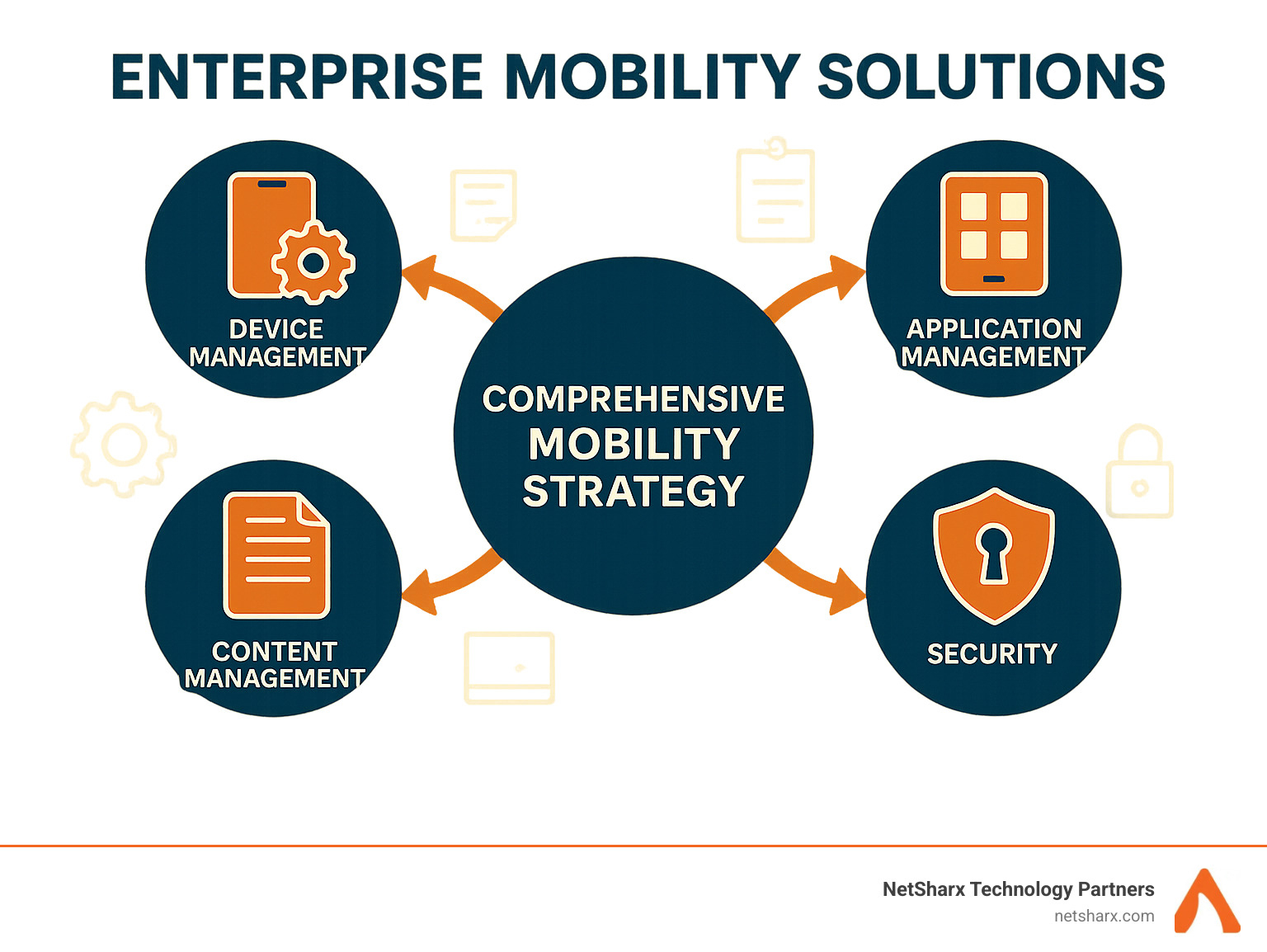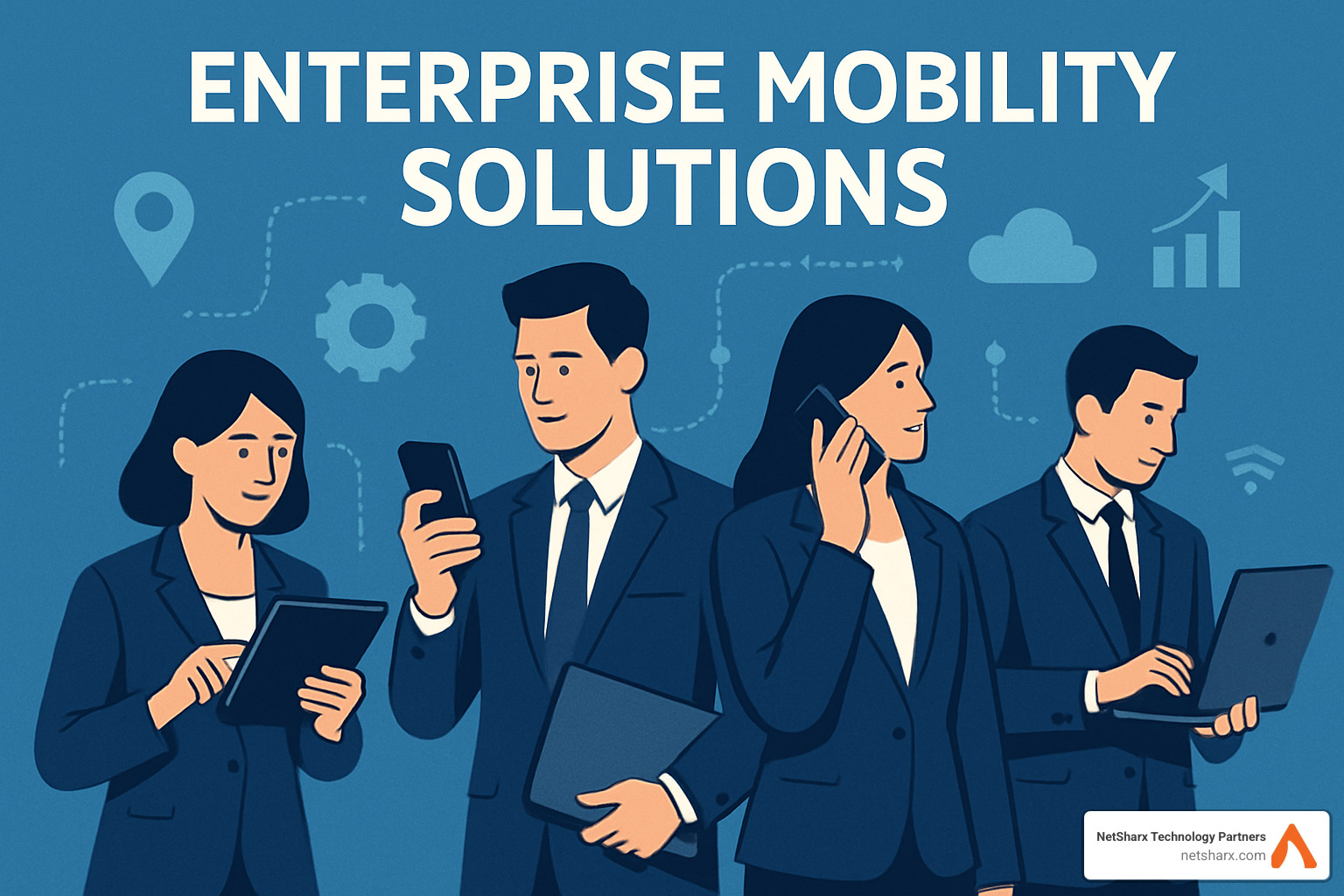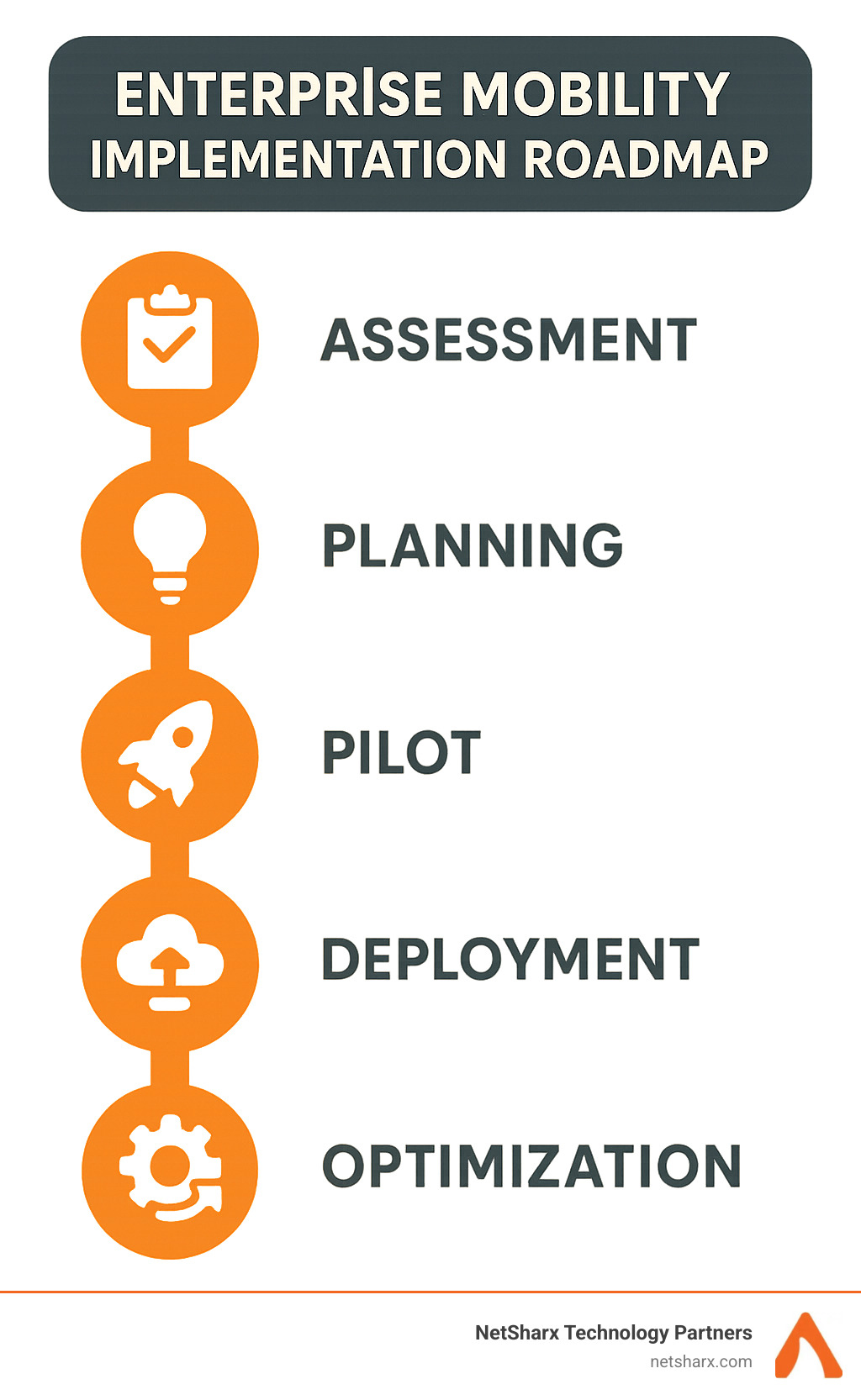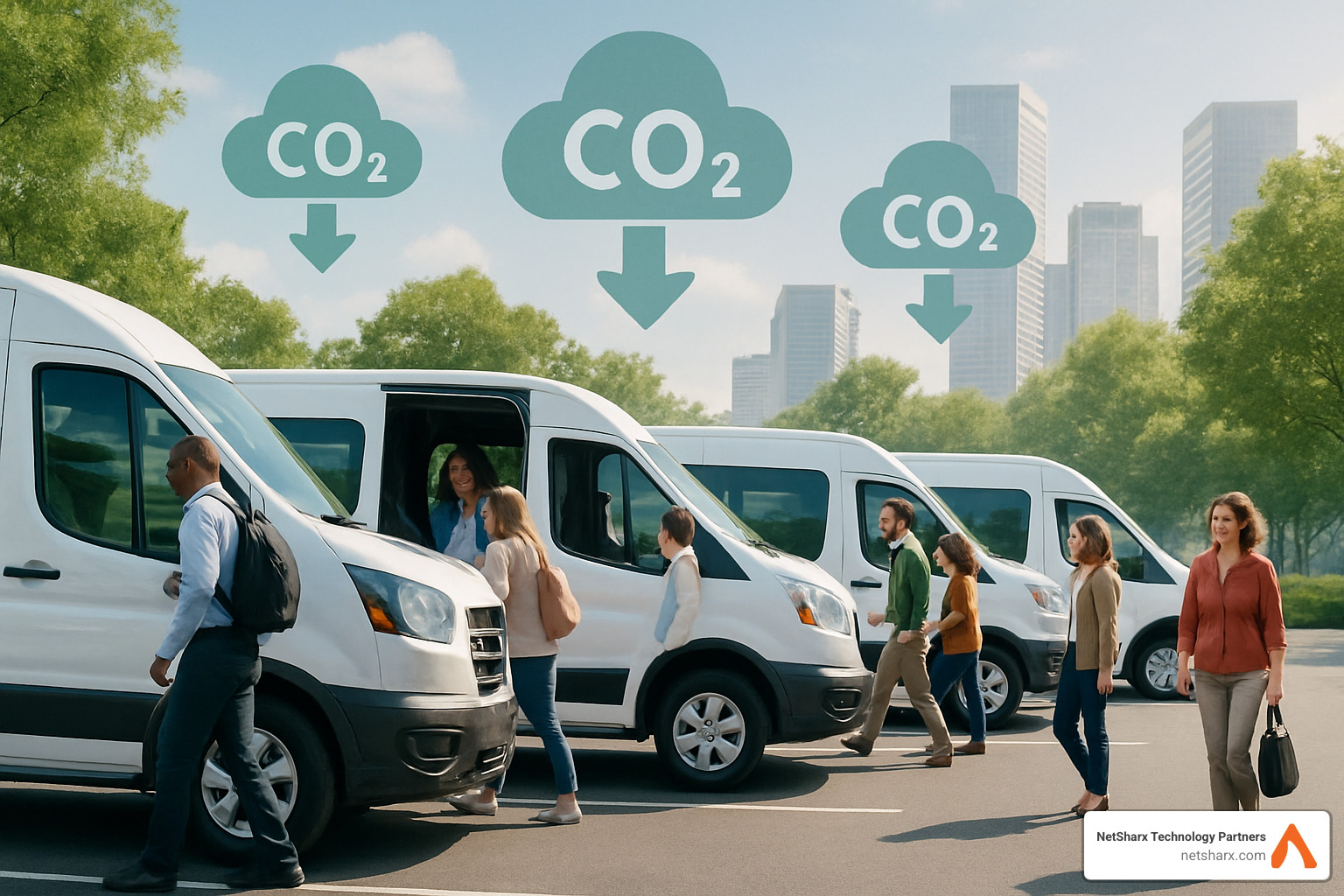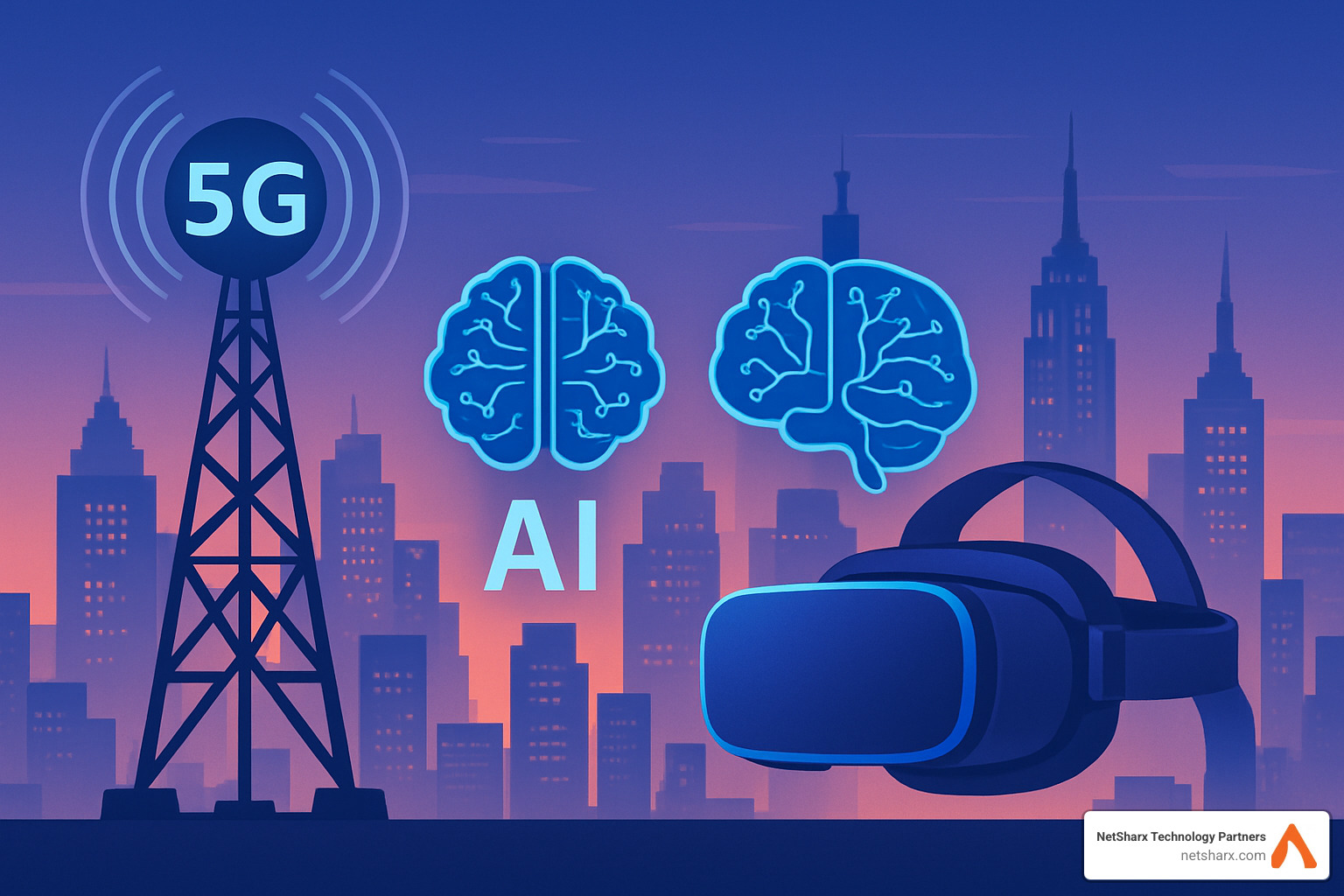Enterprise Mobility Solutions: 7 Powerful Benefits in 2025
Understanding the Modern Mobile Workplace
Enterprise mobility solutions refer to the integration of mobile devices, applications, and technology into business operations and strategies. These solutions enable workers to access company information securely from anywhere, supporting remote work and improving operational efficiency.
What are enterprise mobility solutions?
- Definition: Tools and services that allow employees to work securely on mobile devices from any location
- Core components: Mobile device management (MDM), mobile application management (MAM), secure content access, and identity management
- Benefits: Increased productivity, improved communication, improved data security, and better customer service
- Implementation types: BYOD (Bring Your Own Device), COPE (Company Owned, Personally Enabled), CYOD (Choose Your Own Device)
In today’s digital landscape, businesses face unprecedented challenges in managing an increasingly mobile workforce. The days of employees working solely from their office desktops are long gone. Instead, organizations must adapt to a world where work happens anywhere – in coffee shops, home offices, client sites, warehouses, and on the road.
This shift isn’t just about convenience – it’s fundamentally changing how businesses operate. Companies that accept robust enterprise mobility solutions gain significant competitive advantages through improved productivity, improved communication, and better customer experiences.
Whether you’re looking to implement your first mobility strategy or upgrade existing systems, understanding the core components of enterprise mobility is essential for success in today’s business environment.
I’m Ryan Carter, founder and CEO of NetSharx Technology Partners, and I’ve helped dozens of mid-market and enterprise organizations implement enterprise mobility solutions that reduce costs while improving security and user experience.
Simple guide to enterprise mobility solutions:
– enterprise mobile application management
– enterprise mobile applications
– enterprise mobile security solution
Enterprise Mobility Solutions 101
Defining Enterprise Mobility Solutions
Enterprise mobility solutions go far beyond simply checking email on your smartphone while away from the office. At their heart, these solutions create a work experience that flows seamlessly regardless of where you’re physically located, all while keeping your data secure and your productivity high.
It’s amazing how far we’ve come! Back in 2012, about two-thirds of smartphone owners were already using personal devices for work tasks. Today, that number has skyrocketed, with mobility becoming central to how most businesses operate day-to-day.
Think of enterprise mobility management (EMM) as the perfect trio of people, processes, and technology working together to manage mobile devices and services in your business. This approach brings together device management (securing your hardware), application management (keeping your apps updated and safe), content management (ensuring secure access to company data), identity management (verifying who can access what), and network security (protecting your data as it travels between systems).
For employees who don’t work at desks – like your field technicians, healthcare providers, retail associates, and warehouse staff – enterprise mobility solutions are truly game-changing. Imagine your field service tech pulling up customer history and equipment manuals while on-site, or a nurse viewing patient records right at the bedside. These real-world examples show just how powerful good mobility solutions can be.
Evolution from Transportation to Integrated Mobility
Interestingly, “mobility” in business now covers two different but increasingly connected concepts:
The physical movement of people and goods (transportation mobility) and access to information and systems regardless of location (digital mobility).
Consider how companies in the transportation space have evolved. What might have started as a simple car rental service decades ago has transformed into comprehensive mobility networks offering fleet management, car sharing, vanpooling, subscription models, and connected vehicle technologies.
This shift mirrors how forward-thinking businesses now approach mobility – not as separate transportation and technology initiatives, but as integrated solutions that work together seamlessly. Today’s enterprise mobility solutions combine connected vehicles communicating with central systems, flexible subscription models that go beyond traditional ownership, resource-optimizing shared mobility options, and unified technology platforms that create smooth experiences for everyone involved.
The modern mobility landscape now encompasses everything from traditional fleet management to sophisticated mobile apps and IoT sensors, all working in harmony to create better experiences for your employees and customers alike.
At NetSharx Technology Partners, we understand that implementing the right enterprise mobility solutions requires expertise in both the transportation and digital aspects of mobility. Our approach focuses on finding the perfect balance between security, usability, and cost-effectiveness for your specific business needs.
Scientific research on enterprise mobility confirms what we’ve seen in practice: organizations that accept comprehensive mobility strategies gain significant competitive advantages in today’s fast-moving business environment.
Why Organizations Need Enterprise Mobility Today
In today’s business world, enterprise mobility solutions have transformed from a luxury into a necessity. The shift is happening for good reason – the benefits are simply too valuable to ignore.
Key Benefits of Enterprise Mobility Solutions
The modern workplace doesn’t just want mobility – it demands it. Let me walk you through why this matters so much for today’s organizations.
When your team can work from literally anywhere, magic happens. Productivity skyrockets as employees access critical information exactly when they need it, not hours later when they’re back at their desks. Those old paper-based processes? Gone. Manual data entry? Automated. And when your team can collaborate in real-time regardless of where they’re physically located, work simply flows better.
Communication barriers crumble when everyone connects through the same tools. Think about your deskless workers – those in the field, on the factory floor, or facing customers. With proper mobility solutions, they’re no longer information islands. They can join video calls, respond to messages, and stay in the loop just like their office-bound colleagues. This inclusion creates a more cohesive organization where everyone feels connected.
Your customers will notice the difference too. Customer satisfaction improves dramatically when your team can respond instantly to questions, personalize service based on data they can access on the spot, and complete transactions immediately rather than saying “I’ll have to get back to you on that.” Those frustrating wait times and follow-ups that customers hate? Significantly reduced.
The data advantages are equally impressive. With real-time capture and access, you’ll see better decision-making across your organization. No more duplicate entries, fewer human errors, and most importantly – leaders can make informed choices based on what’s happening right now, not what happened last week.
For organizations with field workers, safety improvements are a compelling reason to accept mobility. Modern solutions offer panic buttons, emergency calling features, fall detection for lone workers, and geofencing capabilities that ensure your team stays safe while they’re out representing your company.
Don’t overlook the sustainability gains either. With optimized routing for field staff, reduced commuting needs, paperless processes, and options like vanpooling, your environmental footprint shrinks while your efficiency grows.
Finally, let’s talk about the bottom line. Despite initial investment costs, enterprise mobility solutions typically deliver impressive returns. Companies regularly see reduced real estate expenses through remote work options, lower travel costs, decreased printing expenses, better workforce utilization, and streamlined IT management. Industry data shows that well-managed mobility programs can reduce device total cost of ownership by 20–30% year over year.
When implemented thoughtfully, mobility solutions don’t just change how you work – they transform what your organization can achieve. The question isn’t whether you need enterprise mobility today, but rather how quickly you can implement it to stay competitive in an increasingly mobile world.
Core Mobility Services & Technologies
The world of enterprise mobility solutions is rich and diverse, with technologies that transform how we work and move. Let’s explore these building blocks that help organizations create mobility strategies that actually work in the real world.
Device & Data Management Essentials
Think of device and data management as the foundation of your mobility house – without it, everything else falls apart.
When your employees use mobile devices for work, you need ways to keep those devices (and your company data) safe and secure. That’s where Mobile Device Management (MDM) comes in. With MDM, your IT team can remotely set up new devices, apply security policies, and even wipe a device if it gets lost in the back of a taxi.
Moving beyond just devices, Mobile Application Management (MAM) helps you control the apps your team uses. Want to make sure everyone has the latest version of your sales app? MAM makes it happen. Need to keep work apps separate from personal apps? MAM creates those secure containers too.
For organizations managing lots of different devices – from smartphones to laptops to tablets – Unified Endpoint Management (UEM) brings everything under one roof. Instead of juggling multiple management systems, UEM gives you one dashboard to rule them all. This simplifies life for your IT team while keeping security consistent across all devices.
Of course, all this mobility creates data security challenges. That’s why enterprise mobility solutions include robust protections like encryption for data (both when it’s moving and when it’s sitting still), secure VPN connections, and multi-factor authentication. These safeguards aren’t just nice-to-have features – they’re essential for meeting regulations like GDPR and HIPAA.
At NetSharx Technology Partners, we help steer these complex technologies, matching you with the right mix of solutions for your specific needs. We don’t believe in one-size-fits-all approaches to mobility.
Connected Vehicle & Fleet Innovations
The transportation side of mobility has undergone its own tech revolution – cars and trucks aren’t just vehicles anymore; they’re rolling computers.
Modern fleet management systems have transformed how organizations handle their vehicles. Telematics systems track everything from location to engine performance in real-time. AI-powered predictive maintenance helps prevent breakdowns before they happen (goodbye, stranded salespeople!). Route optimization reduces both fuel costs and environmental impact.
Take Enterprise Fleet Management as an example – they now manage over 700,000 vehicles across North America, all supported by sophisticated technology platforms.
Beyond traditional ownership, organizations now have access to more flexible transportation options. Car sharing provides on-demand access without the commitment of ownership. Vanpooling creates shared commuting solutions that save money and reduce carbon footprints. Vehicle subscription services offer flexibility without long-term contracts.
The vehicles themselves have become smarter too. Connected vehicle technologies allow for over-the-air software updates (just like your smartphone). Electric vehicles are changing fleet management with new considerations around charging infrastructure. And advanced driver assistance features are making transportation safer for everyone.
These innovations aren’t just cool tech – they’re creating real opportunities for cost savings, operational efficiency, and environmental sustainability. Whether you need help with car rental services, fleet leasing solutions, or mobile device management, the right mix of enterprise mobility solutions can transform how your organization operates.
Want to learn more about keeping all these mobile systems connected? Check out our network connectivity services for the backbone that makes enterprise mobility possible.
Implementing Enterprise Mobility: Factors & Challenges
Let’s face it – rolling out enterprise mobility solutions isn’t as simple as downloading an app and calling it a day. I’ve seen organizations rush into mobility initiatives only to face unexpected roadblocks that could have been avoided with proper planning. The good news? With the right approach, these challenges become manageable stepping stones rather than stumbling blocks.
Building a Secure, User-Friendly Mobility Framework
The most successful mobility implementations start with alignment to business goals. Before selecting any technology, ask yourself: How will these mobile solutions actually support what your business is trying to achieve? Which processes are crying out for mobilization? And importantly, how will you measure success?
Security remains the number one concern when implementing mobility solutions – and with good reason. A 2011 survey showed 75% of CIOs viewed mobile technology as a significant security problem. While technology has evolved, the concerns remain valid. Your mobility framework needs to address device security, network security, application security, and data protection – all while maintaining a seamless user experience.
Speaking of user experience – this can make or break your mobility initiative. I’ve seen perfectly engineered solutions fail simply because users found them frustrating. Focus on creating intuitive interfaces with strong performance that work even when connectivity isn’t perfect. Mobile solutions should simplify workflows, not complicate them.
Integration challenges often surprise organizations. Connecting shiny new mobile apps with older backend systems can be like trying to plug a USB-C cable into an 8-track player. You’ll need to consider API management, data synchronization, and unified authentication systems to create a seamless experience.
Don’t underestimate the human element. The most technically perfect implementation will fail without proper change management. Clear communication about the benefits, comprehensive training, and readily available support are essential. And always create feedback loops so you can quickly identify and address issues.
In-House vs Managed Mobility Services
One of the biggest decisions you’ll face is whether to build and manage your mobility solutions internally or partner with specialists. This isn’t a simple either/or choice – many organizations benefit from a thoughtful hybrid approach.
| Aspect | In-House Management | Managed Mobility Services |
|---|---|---|
| Control | Complete control over all aspects | Strategic control with operational delegation |
| Expertise | Requires building internal skill sets | Leverages specialized provider expertise |
| Cost Model | Capital-intensive with ongoing operational costs | Predictable operational expenses |
| Scalability | Limited by internal resources | Easily scaled with provider capabilities |
| Focus | Diverts IT resources from core business | Allows IT to focus on strategic initiatives |
| Innovation | Dependent on internal capabilities | Benefits from provider’s broader experience |
| Global Support | Challenging to provide consistent worldwide support | Leverages provider’s global capabilities |
In-house management gives you complete control but requires significant expertise and resources. Your IT team needs to become mobility experts on top of their existing responsibilities, which can pull focus from core business initiatives.
Managed mobility services, on the other hand, provide access to specialized expertise and global capabilities with predictable costs. This approach lets your IT team concentrate on strategic initiatives rather than mobility troubleshooting.
At NetSharx Technology Partners, we’ve found that many organizations benefit from a hybrid approach – maintaining strategic control while delegating operational aspects to specialists. We help clients objectively evaluate their options, considering their unique constraints and objectives to find the right balance.
Successful enterprise mobility solutions implementation isn’t about choosing the most advanced technology – it’s about selecting and implementing the right solutions for your specific business needs.
Sustainability & Innovation Through Mobility
When we talk about enterprise mobility solutions, we’re not just discussing technology that makes work more convenient. These solutions are becoming powerful drivers of sustainability and innovation across organizations of all sizes.
Environmental Impact
You might be surprised how much enterprise mobility solutions can help your company go green. When employees can work remotely, they’re not commuting daily—which means fewer cars on the road and less carbon being pumped into our atmosphere. But that’s just the beginning.
Smart fleet management systems help drivers take the most efficient routes, saving fuel and reducing emissions. Mobile workflows eliminate the need for paper documents (goodbye filing cabinets!), and shared transportation options like vanpools mean fewer vehicles on the road overall.
The impact can be remarkable. One commuter shuttle program we worked with eliminated over one billion miles of single-occupancy vehicle travel. That’s not a typo—one billion miles! This translated to a reduction of more than 400,000 metric tons of CO₂e. That’s roughly equivalent to taking 87,000 cars off the road for an entire year.
Innovation Catalysts
Mobility doesn’t just help the environment—it sparks innovation throughout your organization. When you introduce mobile capabilities, teams naturally begin to question and reimagine traditional workflows. “We’ve always done it this way” gets replaced with “What if we tried this instead?”
The data collected through mobile solutions provides new insights that weren’t possible before. Customer interactions transform as mobile touchpoints create opportunities for personalized engagement. Perhaps most importantly, your workforce feels empowered when they have the tools to contribute ideas and improvements from anywhere.
As Ryan, our founder, often says: “Mobility isn’t just about working differently—it’s about thinking differently.”
Real-World Impact Stories
Enterprise Success Cases
Let’s look at how real organizations are benefiting from enterprise mobility solutions:
In healthcare, doctors and nurses with secure mobile access to patient records make better treatment decisions right at the bedside. One hospital system we worked with saw a 22% improvement in patient satisfaction scores after implementing a mobile charting solution.
Field service has been revolutionized by mobility. Technicians arrive at job sites with complete customer histories, equipment manuals, and inventory information at their fingertips. They complete more service calls per day and fix problems right the first time—no more “I’ll have to come back with the right part” conversations.
Retail associates equipped with mobile devices can check inventory, look up customer preferences, and even complete transactions without sending shoppers to wait in checkout lines. One retailer saw a 15% increase in average transaction value after putting mobile tools in their associates’ hands.
Manufacturing floors are becoming smarter as workers use tablets and wearables to monitor production data in real-time. Quality issues get addressed immediately rather than finded during end-of-line inspections.
Community Impact
The benefits of enterprise mobility solutions extend beyond business outcomes to create positive impacts in our communities:
Vanpooling programs reduce traffic congestion and parking demands while providing affordable transportation options for workers. Shared mobility increases transportation access for underserved communities that might otherwise face limited options.
Remote work capabilities open employment opportunities in rural or economically disadvantaged areas where jobs might otherwise be scarce. And the reduced emissions from all these initiatives lead to improved air quality and better public health outcomes for everyone.
These real-world examples show how enterprise mobility solutions deliver value that goes well beyond operational efficiency. They contribute to broader societal and environmental goals while helping your organization meet its business objectives—truly a win-win solution.
At NetSharx Technology Partners, we’re passionate about helping organizations find the mobility solutions that will drive both sustainability and innovation for years to come.
Selecting the Right Mobility Partner
Choosing the right partner for your enterprise mobility solutions isn’t just another vendor decision—it’s a relationship that will shape how your workforce connects, communicates, and collaborates for years to come. Let’s walk through how to find your perfect mobility match.
Needs Assessment
Before you start speed-dating potential partners, take a good look in the mirror:
Start with an honest assessment of where you stand today. What mobility tools are already working well? Where are the pain points that keep your IT team up at night? Understanding your current landscape creates the foundation for everything that follows.
Think about what you’re really trying to accomplish. Are you primarily focused on boosting field productivity? Improving customer experience? Strengthening security? Your objectives will guide which partners have the right expertise for your journey.
Don’t forget to talk to the people who’ll actually use these solutions. The perfect technical solution on paper becomes worthless if your team finds it frustrating or complicated. Different departments often have different needs too—sales teams, field technicians, and executives each have their own mobility priorities.
Your technical environment matters enormously here. Which systems will need to play nicely with your new mobility solutions? Are you heavily invested in certain platforms that a partner would need experience with?
Finally, know your compliance landscape. Healthcare organizations face HIPAA requirements, financial institutions have their own regulatory frameworks, and international operations bring GDPR considerations. Your partner needs to understand your specific compliance world.
Partner Evaluation Criteria
When you’re ready to evaluate potential mobility partners, focus on these key areas:
1. Expertise and Experience
Look for partners who speak your industry language. A partner with deep experience in manufacturing will understand your shop floor mobility needs in ways a generalist never could.
Check their technical credentials—do they have certifications from major mobility solution providers? Can they show you similar organizations they’ve successfully helped? The best partners offer a full spectrum of mobility services rather than just one narrow slice.
2. Solution Approach
The right partner should be technology-agnostic, recommending what’s truly best for you rather than what’s most profitable for them. Some situations call for custom solutions while others are perfect for established platforms—they should know the difference.
Pay attention to their implementation methodology. Do they have a clear, proven process that minimizes disruption? Great partners also recognize that technology is only part of the equation—they should have thoughtful approaches to change management and training.
3. Support and Service
When mobility issues arise (and they will), how quickly will your partner respond? Review their Service Level Agreements carefully and understand their escalation procedures. Round-the-clock support isn’t just nice to have—it’s essential when your global workforce spans multiple time zones.
The best partners don’t just wait for problems; they proactively monitor and manage your mobility environment to prevent issues before they impact your business.
4. Innovation and Future-Readiness
Technology evolves rapidly. Today’s cutting-edge solution can quickly become tomorrow’s legacy burden. Look for partners with clear roadmaps for how their mobility offerings will evolve. Are they investing in research and development? How are they approaching emerging technologies like 5G and AI?
Your needs will change too. The ideal partner demonstrates flexibility to adapt alongside your business, not just delivering what you need today but positioning you for future success.
5. Total Cost of Ownership
Understanding the true cost goes beyond the initial price tag. Examine their pricing model carefully—is it subscription-based, usage-based, or something else? What costs might be hiding between the lines?
A good partner helps you build a solid ROI analysis and offers strategies to optimize costs over time. They should be transparent about how their pricing works and when changes might occur.
Evaluation Checklist for Mobility Providers
When you’re meeting with potential partners, bring along this handy checklist to ensure you’re covering all the bases:
- ☐ Provides technology-agnostic recommendations
- ☐ Offers comprehensive security capabilities
- ☐ Demonstrates understanding of your industry
- ☐ Presents clear implementation methodology
- ☐ Provides transparent pricing model
- ☐ Offers flexible contract terms
- ☐ Maintains relevant certifications and partnerships
- ☐ Delivers 24/7 support capabilities
- ☐ Shows proven track record with references
- ☐ Demonstrates innovation and future vision
- ☐ Provides change management and training
- ☐ Offers integration expertise with existing systems
At NetSharx Technology Partners, we believe in matchmaking, not selling. As a technology broker with an extensive network of providers, we help organizations steer the complex mobility landscape without pushing them toward pre-determined solutions. We’re proud of our unbiased approach to solution engineering—finding the perfect fit for your specific needs, not forcing you into a one-size-fits-all box.
Think of us as your mobility matchmaker, helping you find a partner who truly gets you, supports your vision, and helps your organization thrive in an increasingly mobile world.
Future Trends Shaping Enterprise Mobility Solutions
The landscape of enterprise mobility solutions continues to evolve rapidly. Understanding emerging trends helps organizations prepare for future opportunities and challenges:
5G and Edge Computing
Remember when waiting for apps to load on your phone was just part of life? Those days are quickly disappearing. The rollout of 5G networks paired with edge computing is completely changing what’s possible in the mobile workspace.
With ultra-low latency, applications that need split-second responsiveness can now run smoothly on mobile devices. Think of a field technician using augmented reality to guide a complex repair – the visual overlays need to appear instantly as they move their head, with no delay.
5G also supports massive device connectivity, allowing exponentially more connected devices in the same area without congestion. This means dense IoT deployments in warehouses or manufacturing floors can operate reliably.
The improved bandwidth isn’t just about faster downloads – it enables rich media and data-intensive applications that simply weren’t practical before. And with edge processing moving computation closer to where data is created, organizations can process information faster while reducing bandwidth needs and costs.
AI and Intelligent Assistance
AI is no longer just a buzzword – it’s becoming your employees’ digital partner throughout the workday.
AI copilots with natural language interfaces are making complex enterprise systems accessible to everyone. Rather than navigating complicated menus, a field worker can simply ask, “Show me the maintenance history for this equipment” or “Order replacement parts for this unit.”
We’re seeing predictive analytics anticipate needs before they arise. For example, an AI system might alert a technician that a part is likely to fail based on sensor readings, allowing them to replace it during a scheduled visit rather than making an emergency call later.
Automated workflows are reducing tedious manual steps. When a sales rep takes a photo of a receipt, AI can automatically extract the information, categorize the expense, and submit it for approval without any typing.
SAP’s integration of an AI copilot called Joule exemplifies this trend, enabling voice-driven mobile business tasks that make complex enterprise systems more accessible to mobile users.
Mixed Reality
The line between physical and digital workspaces is blurring, and it’s changing how we think about mobile work.
Augmented reality (AR) overlays digital information on the physical world, helping workers complete complex tasks with visual guidance. Imagine a new warehouse employee wearing smart glasses that highlight exactly which items to pick and where to find them.
Virtual reality (VR) creates immersive digital environments that are revolutionizing training and collaboration. New employees can practice dangerous procedures safely, and teams can collaborate in shared virtual spaces regardless of physical location.
Digital twins – virtual replicas of physical assets – allow remote monitoring and management of equipment. A factory manager can “walk through” a facility from hundreds of miles away, checking machine status and performance in real time.
These technologies aren’t science fiction anymore – they’re becoming essential tools for forward-thinking organizations.
Evolving Security Models
As mobility expands, security approaches are adapting to new threats and challenges.
The Zero Trust architecture approach is gaining traction, requiring verification for every access request regardless of source. This means even if a device is recognized, additional verification is still required based on behavior patterns, location, and other factors.
We’re moving beyond point-in-time verification to continuous authentication, where systems constantly validate that the authorized user is still the one using the device. Subtle factors like typing patterns, movement, and app usage help verify identity throughout a session.
Behavioral analytics can identify anomalous patterns that may indicate security threats. If an employee suddenly accesses unusual files or connects from an unexpected location, systems can flag this for review or require additional authentication.
These evolving security models provide stronger protection while maintaining a smooth user experience – the best security is the kind users barely notice.
Microexperiences and Composable Applications
The days of one-size-fits-all mobile apps are fading. Today’s trend is toward purpose-built experiences custom to specific tasks and roles.
Microexperiences are mini-applications designed for specific tasks, allowing workers to quickly accomplish goals without navigating complex interfaces. Think of a delivery driver who needs only a simplified navigation and delivery confirmation tool, not the company’s entire logistics system.
Composable architecture treats applications as collections of interchangeable components that can be assembled to meet specific needs. This allows organizations to quickly create custom mobile experiences without building everything from scratch.
The rise of low-code/no-code development is democratizing app creation, enabling business users to create mobile solutions without extensive programming knowledge. This speeds development and ensures applications truly meet business needs.
This approach is particularly valuable for temporary and gig workers who need custom mobile experiences without complex onboarding – they can get just the tools they need, configured exactly for their role.
Sustainability Focus
Environmental considerations have moved from nice-to-have to essential in mobility strategies.
Organizations are implementing carbon tracking to measure and report on the environmental impact of their mobility programs. This includes not just vehicle emissions, but also the carbon footprint of device manufacturing and energy usage.
Sustainable transportation options like electric vehicles and shared mobility services are becoming central to corporate mobility programs. Companies are incentivizing carpooling, vanpooling, and public transit while transitioning fleets to electric vehicles.
Improved remote collaboration tools are reducing the need for business travel, cutting both costs and carbon emissions. And paperless processes eliminate physical documentation, reducing waste while improving efficiency.
At NetSharx Technology Partners, we help organizations steer these emerging trends, identifying which innovations will deliver the most value for their specific needs and challenges. The future of enterprise mobility solutions is exciting – and we’re here to help you make the most of it.
Frequently Asked Questions about Enterprise Mobility
What is the difference between MDM and UEM?
When you’re navigating enterprise mobility solutions, you’ll often hear about MDM and UEM. Let me clear up the confusion between these two important technologies.
Mobile Device Management (MDM) is like having a specialized tool just for your smartphones and tablets. It handles the basics—enrolling new devices, setting them up with your company’s configurations, and implementing security measures to keep your mobile data safe.
Unified Endpoint Management (UEM), on the other hand, is the comprehensive approach. Think of it as MDM’s bigger sibling that’s grown up to handle everything—not just phones and tablets, but laptops, desktops, IoT devices, and whatever new gadget might appear on your network tomorrow.
The difference matters for most businesses. UEM gives you that single pane of glass to manage all your devices, which means consistent security policies across your entire technology ecosystem. It typically integrates more deeply with your identity management systems and offers more sophisticated automation capabilities.
I’ve seen many of our clients at NetSharx Technology Partners make the shift from MDM to UEM as their mobility needs mature. It simplifies life for IT teams and creates a more consistent experience for users—a win-win that’s hard to ignore in today’s complex device landscape.
How do enterprise mobility solutions support remote work?
Remote work isn’t just a trend anymore—it’s a fundamental part of how modern businesses operate. Enterprise mobility solutions serve as the backbone that makes effective remote work possible.
Imagine your team members working from their kitchen tables, co-working spaces, or even beachside cabanas. What makes this possible? Secure connections to your company’s resources through VPNs and conditional access controls ensure that only the right people access sensitive data, regardless of their location.
Beyond basic access, true productivity depends on collaboration. Mobile-optimized communication platforms keep your team connected through video calls, instant messaging, and virtual workspaces that function just as well on a smartphone as they do on a laptop.
Documents and data flow seamlessly through secure file-sharing systems, ensuring everyone works from the same information. Mobile versions of your critical business applications mean work continues uninterrupted, whether someone’s in the office or on the go.
What about security? That’s where features like remote wipe capabilities, encryption, and policy enforcement come into play—protecting your corporate data even when it lives on personal devices.
And when technical issues arise (as they inevitably do), remote support tools allow your IT team to troubleshoot problems without requiring an in-person visit.
All these capabilities combine to create an experience where location becomes irrelevant to productivity—the true promise of mobility in today’s workplace.
What ROI can I expect from deploying mobility solutions?
When clients ask me about the return on investment for enterprise mobility solutions, I always tell them that the numbers can be impressive—but they vary widely depending on your specific implementation and goals.
Most organizations see tangible benefits in several key areas. Productivity typically jumps by 20-40% when employees have mobile access to the tools and information they need. This isn’t surprising when you consider how mobility eliminates downtime and enables work during previously “dead” time like commutes or while waiting for appointments.
Resolution times for issues often drop by 30-50% when field teams have mobile access to knowledge bases, expert support, and real-time data. This translates directly to improved customer satisfaction and higher Net Promoter Scores.
On the cost side, properly managed mobility services typically reduce the total cost of ownership for devices by 20-30%—savings that add up quickly across a large organization. And as remote work capabilities expand, many businesses find they can significantly reduce their real estate footprint and associated costs.
One of my favorite ROI stories comes from a client who eliminated their paper-based workflows through mobile forms and approvals. Beyond the obvious savings on paper and printing, they finded dramatic improvements in process completion times and data accuracy that delivered value far beyond their initial projections.
To calculate the potential ROI for your specific situation, we at NetSharx Technology Partners typically help you identify the processes you’ll mobilize, establish baseline metrics, estimate improvements based on industry benchmarks, and factor in both implementation and ongoing costs. We look at both tangible and intangible benefits to build a comprehensive picture of the value mobility will bring to your organization.
The bottom line? When implemented thoughtfully, enterprise mobility solutions don’t just pay for themselves—they often become one of your most valuable technology investments.
Conclusion
The journey through enterprise mobility solutions reveals a fascinating evolution – what began as simple conveniences have transformed into essential business infrastructure. Throughout this guide, we’ve seen how mobility now encompasses both the technology empowering work-from-anywhere capabilities and the transportation solutions moving people and goods efficiently across our connected world.
Today’s forward-thinking organizations approach mobility holistically. They understand that success comes from balancing several critical elements: empowering employees with mobile technology that improves customer experiences, meeting transportation needs through flexible and sustainable options, maintaining rock-solid security across diverse devices and locations, and ensuring data flows seamlessly between mobile and fixed environments.
The rewards for getting this right are substantial. Organizations implementing thoughtful mobility strategies enjoy increased productivity as employees work efficiently from anywhere. They benefit from dramatically improved communication that bridges gaps between office and field workers. Their customers experience better service through real-time information access. They make smarter decisions through better data management. And importantly, they gain tangible benefits in safety, sustainability, and significant cost savings.
But let’s be honest – implementing effective mobility solutions isn’t always straightforward. It requires careful planning and trustworthy partnerships to steer complex decisions around security frameworks, user experience design, system integration challenges, and deployment models.
At NetSharx Technology Partners, helping organizations steer these challenges is our specialty. As a technology broker with relationships across the industry, we bring unique advantages to your mobility journey:
- We provide truly agnostic solution engineering based on your specific needs, not vendor relationships
- Our established provider network translates into competitive pricing for your organization
- We offer comprehensive support that stays with you throughout implementation and beyond
- We focus on ongoing optimization, ensuring your mobility solutions evolve alongside your business
Looking ahead, the future of enterprise mobility solutions promises even greater possibilities. The combination of 5G networks, artificial intelligence, mixed reality experiences, and other emerging technologies will create opportunities we’re just beginning to imagine. Organizations that build strong mobility foundations today will be perfectly positioned to capitalize on these innovations tomorrow.
Ready to transform your approach to enterprise mobility? Contact us to find how we can help you create a mobility strategy that drives business success while making technology management refreshingly simple. Let’s build your roadmap to continuous improvement together.

